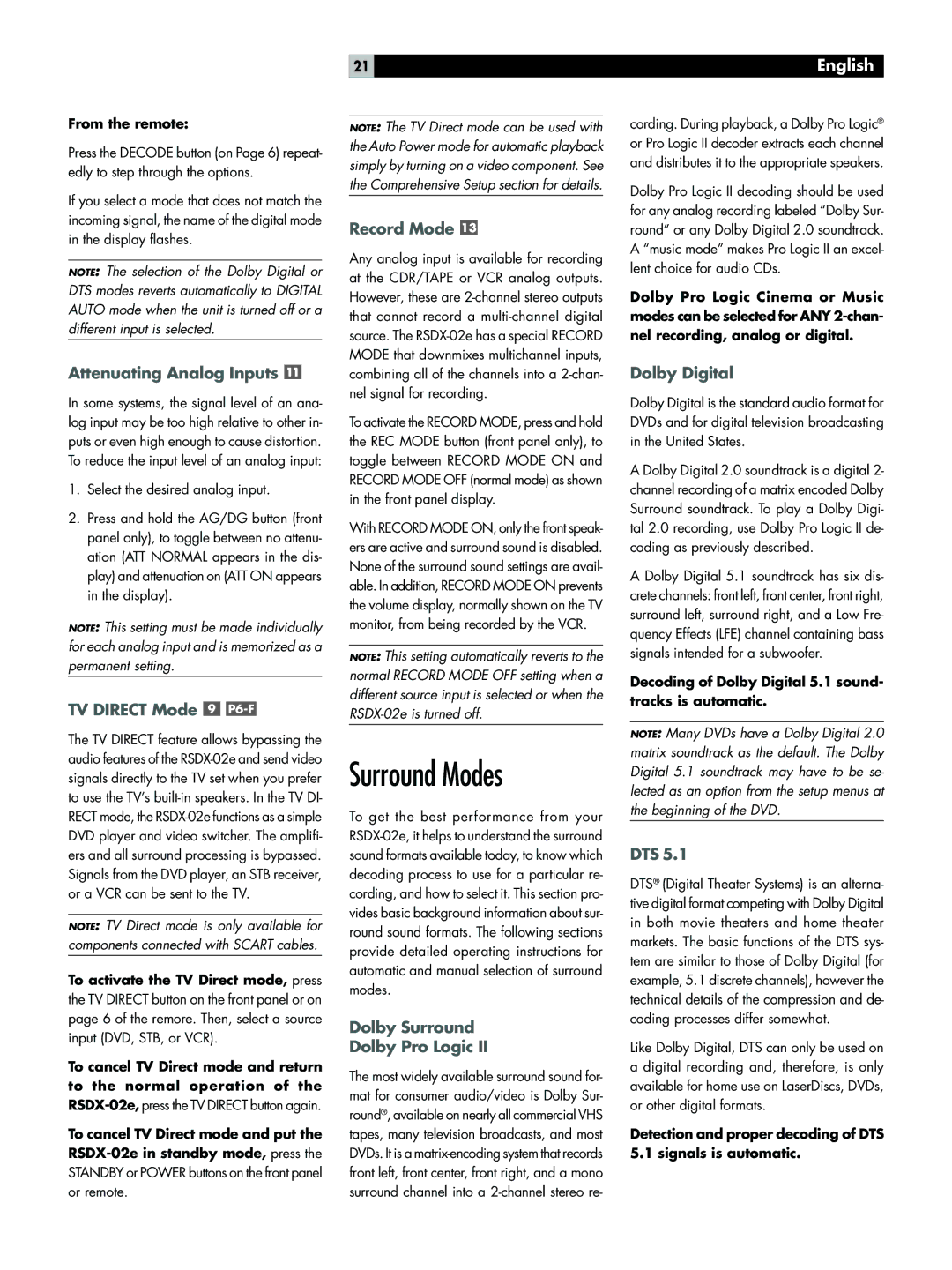
21 | English |
From the remote:
Press the DECODE button (on Page 6) repeat- edly to step through the options.
If you select a mode that does not match the incoming signal, the name of the digital mode in the display flashes.
NOTE: The selection of the Dolby Digital or DTS modes reverts automatically to DIGITAL AUTO mode when the unit is turned off or a different input is selected.
Attenuating Analog Inputs 
In some systems, the signal level of an ana- log input may be too high relative to other in- puts or even high enough to cause distortion. To reduce the input level of an analog input:
1.Select the desired analog input.
2.Press and hold the AG/DG button (front panel only), to toggle between no attenu- ation (ATT NORMAL appears in the dis- play) and attenuation on (ATT ON appears in the display).
NOTE: This setting must be made individually for each analog input and is memorized as a permanent setting.
TV DIRECT Mode 
P6-F
The TV DIRECT feature allows bypassing the audio features of the
NOTE: TV Direct mode is only available for components connected with SCART cables.
To activate the TV Direct mode, press the TV DIRECT button on the front panel or on page 6 of the remore. Then, select a source input (DVD, STB, or VCR).
To cancel TV Direct mode and return to the normal operation of the
To cancel TV Direct mode and put the
STANDBY or POWER buttons on the front panel or remote.
NOTE: The TV Direct mode can be used with the Auto Power mode for automatic playback simply by turning on a video component. See the Comprehensive Setup section for details.
Record Mode 
Any analog input is available for recording at the CDR/TAPE or VCR analog outputs. However, these are
To activate the RECORD MODE, press and hold the REC MODE button (front panel only), to toggle between RECORD MODE ON and RECORD MODE OFF (normal mode) as shown in the front panel display.
With RECORD MODE ON, only the front speak- ers are active and surround sound is disabled. None of the surround sound settings are avail- able. In addition, RECORD MODE ON prevents the volume display, normally shown on the TV monitor, from being recorded by the VCR.
NOTE: This setting automatically reverts to the normal RECORD MODE OFF setting when a different source input is selected or when the
Surround Modes
To get the best performance from your
Dolby Surround
Dolby Pro Logic II
The most widely available surround sound for- mat for consumer audio/video is Dolby Sur- round®, available on nearly all commercial VHS tapes, many television broadcasts, and most DVDs. It is a
cording. During playback, a Dolby Pro Logic® or Pro Logic II decoder extracts each channel and distributes it to the appropriate speakers.
Dolby Pro Logic II decoding should be used for any analog recording labeled “Dolby Sur- round” or any Dolby Digital 2.0 soundtrack. A “music mode” makes Pro Logic II an excel- lent choice for audio CDs.
Dolby Pro Logic Cinema or Music modes can be selected for ANY
Dolby Digital
Dolby Digital is the standard audio format for DVDs and for digital television broadcasting in the United States.
A Dolby Digital 2.0 soundtrack is a digital 2- channel recording of a matrix encoded Dolby Surround soundtrack. To play a Dolby Digi- tal 2.0 recording, use Dolby Pro Logic II de- coding as previously described.
A Dolby Digital 5.1 soundtrack has six dis- crete channels: front left, front center, front right, surround left, surround right, and a Low Fre- quency Effects (LFE) channel containing bass signals intended for a subwoofer.
Decoding of Dolby Digital 5.1 sound- tracks is automatic.
NOTE: Many DVDs have a Dolby Digital 2.0 matrix soundtrack as the default. The Dolby Digital 5.1 soundtrack may have to be se- lected as an option from the setup menus at the beginning of the DVD.
DTS 5.1
DTS® (Digital Theater Systems) is an alterna- tive digital format competing with Dolby Digital in both movie theaters and home theater markets. The basic functions of the DTS sys- tem are similar to those of Dolby Digital (for example, 5.1 discrete channels), however the technical details of the compression and de- coding processes differ somewhat.
Like Dolby Digital, DTS can only be used on a digital recording and, therefore, is only available for home use on LaserDiscs, DVDs, or other digital formats.
Detection and proper decoding of DTS 5.1 signals is automatic.
